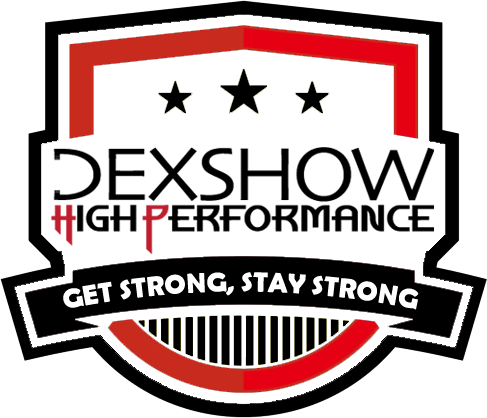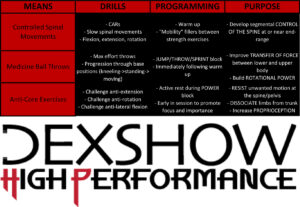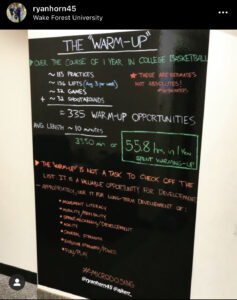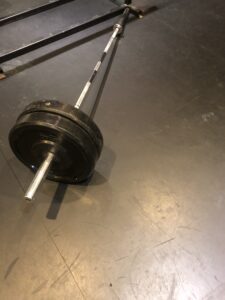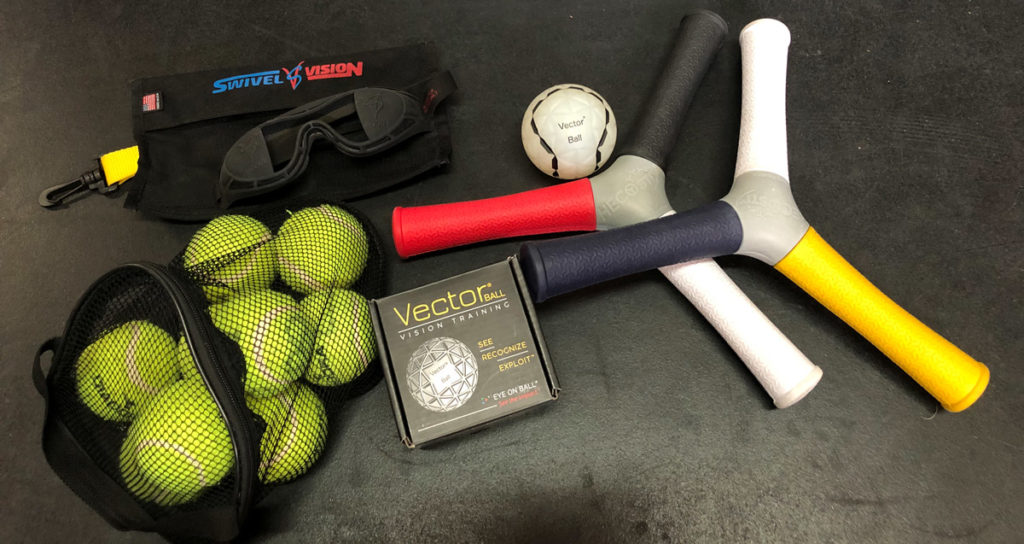
With all organized sports cancelled for the foreseeable future, I’ve been getting some questions from parents about hand-eye drills for their kids. I started writing about my thoughts on hand-eye coordination and how to incorporate it into a solid training program but realized several hours in that I needed to split up my posts on the subject. If you search #handeyecoordination on Instagram, you’ll find over 70,000 posts of people juggling balls, catching multi-coloured foam sticks, reacting to blinking lights, or doing all of those things at the same time. In Part I, I’ll go over WHAT hand-eye coordination is, HOW I categorize hand-eye drills for athletes, and WHY incorporating appropriate hand-eye training can help boost sports performance (and WHY random drills off of the internet will NOT). Part II will cover EQUIPMENT AND EXAMPLES of drills across my hand-eye continuum, WHO can benefit the most, and WHEN I program hand-eye development into my athletes’ training programs.
WHAT IS HAND-EYE COORDINATION?
The golden standard of internet knowledge – Wikipedia – defines hand-eye coordination as: “the coordinated control of eye movement with hand movement and the processing of visual input to guide reaching and grasping along with the use of proprioception of the hands to guide the eyes.” I think hand-eye coordination is definitely a trainable quality but in order to make an effective strategy for improving it, we have to break it down into pieces and learn how to improve each piece independently, before the skill, as a whole, progresses. At the most basic level, hand-eye coordination is about proprioception – instinctively knowing where our body is in space – and interpreting visual stimuli – the information our brain receives from our eyes. We start to learn hand-eye coordination and improve it from the time we are infants, reaching for mobiles and toys, then by manipulating blocks to fit into certain shaped holes, scribbling on paper and eventually learning to write. All of these inherent human skills rely on executing a task based on the visual stimuli we perceive from the environment. The most basic way to improve hand-eye coordination is to improve both proprioception and visual inputs. Here are two examples of training proprioception:
Daily CARs Routine (video sped up 5x)– stimulating the mechanoreceptors in the joints at end range sends input to the brain to bring awareness to where and what the body is doing with a focus on controlling and isolating joint movement.
Snap Proprioception Drill – removing visual cues from the equation forces the athlete to rely on sound and knowing where they are in space.
Training your ocular musculature (the muscles that control your eyes) through visual tracking drills and eye movement exercises are an effective way to improve your ability to see and interpret visual stimuli. Here you can see two NHL goalies – Brayden Holtby and Connor Hellebuyck – warming up their eye musculature before a game:
Now, if we start to meld proprioceptive training AND visual training at the same time, it begins to look like what we call hand-eye coordination drills. I’m a very Type-A person. I need charts, graphs, data to help me make decisions, and it all has to be organized. I started thinking about hand-eye drills after seeing a bunch of them online and wanted to start cataloguing and, more importantly, categorizing them.
HOW CAN DRILLS BE CATEGORIZED?
Broadly, there are two distinct types of hand-eye drills: REACTIVE HAND-EYE DRILLS and COGNITIVE HAND-EYE DRILLS.
REACTIVE hand-eye drills effectively challenge the SPEED at which the athlete can complete a task. Furthermore, REACTIVE drills can usually be placed somewhere along this continuum I came up with:
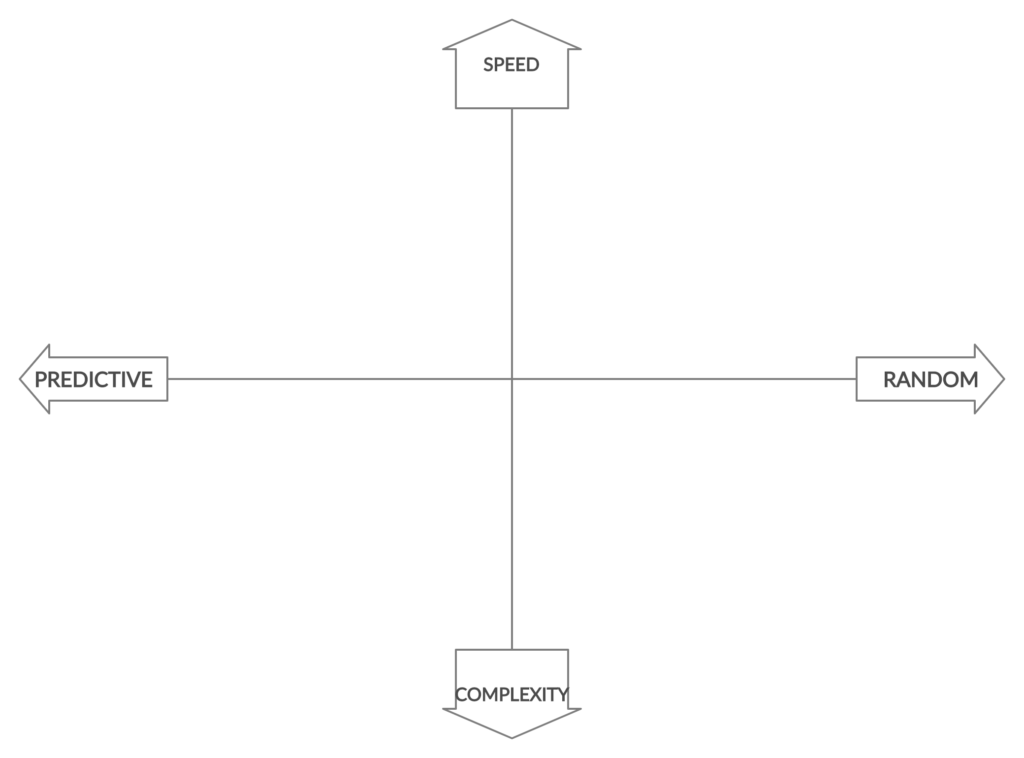
The farther left a drill sits on the continuum, the more predictive the reaction will be. As you move to the right, the reaction required to execute the task becomes more random. When designing REACTIVE hand-eye drills, a coach can also manipulate the speed of the reaction needed to complete the task, and/or the complexity of the task. Let’s say we want to make a drill where the task is to catch a tennis ball. On the far left of the continuum and close to the X-axis, the athlete will throw the ball up in the air themselves and then catch it. This is very predictive in that the athlete knows when and where they will throw the ball, speed is defined by gravity and is relatively slow, and the complexity is limited – no constraints besides catching the ball. To increase the challenge for the athlete, we can move the drill right and up on the continuum by bouncing the ball to the athlete off of a box at a higher speed. The drill has now become more random because a 2nd party is throwing the ball and the speed needed to execute the task has increased. Using a reaction ball (a ball that is not spherical) increases randomness in the drill and moves the drill even farther to the right. Implementing 2 balls or using a smaller ball are examples of increasing this drill’s complexity, moving the drill lower on the continuum.
THE FARTHER A DRILL FALLS ON THE RIGHT OF THE CONTINUUM AND/OR THE FARTHER IT IS FROM THE X-AXIS, THE MORE CHALLENGING IT IS FOR THE ATHLETE.
COGNITIVE hand-eye drills seek to challenge how fast an athlete can make the correct DECISION to satisfy the task, and then act on it. When developing COGNITIVE hand-eye drills, we can almost think of them as a flow chart of “IF THIS, THEN THAT.” The athlete interprets the stimuli of the drill and has to make a choice based on the inputs to complete the task. These drills somewhat simulate the split-second decisions that athletes must make constantly in sports. COGNITIVE drills are progressed by using more choice options, limiting the time available to make a choice, or by changing the task based on the information provided. There is an emerging field in Strength and Conditioning based on challenging athletes cognitively called Perception-Reaction Coupling. This comes down to the same decision-making processes as hand-eye drills but on a much more global scale. For the purpose of this post, we are sticking to hand-eye drills for improving cognition. When applying hand-eye coordination training to your athlete, use both REACTIVE and COGNITIVE drills to challenge them and drive positive change.
WHY TRAINING HAND-EYE COORDINATION CAN IMPROVE SPORTS PERFORMANCE
Nearly all sports require a combination of REACTIVE and COGNITIVE qualities (along with many other physical qualities), so its no surprise that training and improving reactivity and cognition can increase sports performance. Good hand-eye coordination training PROGRESSIVELY challenges the athlete’s ability to execute a task based of the information garnered visually. Progressively is the key word here. There is no need for seeing “drills” online and trying to have your kid or your athlete perform them without first mastering the basics or understanding the purpose. It’s being irresponsible as a parent/coach. You wouldn’t start a child with calculus if they didn’t know addition, reading if they didn’t know the letters, lifting heavy if they couldn’t move their own bodyweight – the same goes for hand-eye. The beauty of having a system to place drills along a continuum is that you can constantly evolve and challenge the athlete’s overall hand-eye coordination while also recognizing what specific quality you are actually training. Training implies systematic improvements, improvements require an adequate stimulus, an adequate stimulus is achieved when a system is stressed enough to adapt positively. To truly make change, PARENTS AND COACHES NEED TO SELECT HAND-EYE DRILLS THAT CHALLENGE THE ATHLETE’S ABILITY TO EXECUTE THE TASK BY MANIPULATING A COMBINATION OF RANDOMNESS, SPEED, OR COMPLEXITY. PERIOD. Lobbing tennis balls in to your kid with a goalie glove on from 30 feet away IS NOT hand-eye training! Sure it is fun and fills quarantine time – GREAT! – but don’t call it training. True hand-eye training is challenging. The athlete will not be successful on every rep – if they are, move the drill along the continuum to actually stimulate positive adaptations and improve qualities that will make the individual a better athlete. Side note here: hand-eye training should make up a small portion of an athlete’s overall training regimen. There are many more important athletic qualities like strength, stability, power, or speed that need to be developed by using a majority of the athlete’s training time.
I hope Part I has clarified some important information about hand-eye training – what it is, how to categorize your drills, and why it can improve sports performance. Part II will show you examples of equipment I use to train hand-eye coordination, including some drills, and also how and when I implement drills into an athlete’s training program.
Get strong, stay strong.
Coach Dex
